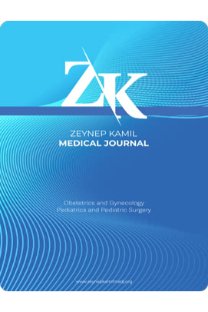Prokalsitonin'in Çocukluk Çağı Nötropenik Ateşinde Tanısal Değeri
Assessment of Procalcitonin as Diagnostic Marker in Children with Neutropenic Fever
___
- 1. White L, Ybarra M. Neutropenic fever. Emerg Med Clin North Am. 2014 Aug; 32(3):549-61.
- 2. Gozzard DI, French EA, Blecher TE, Powell JR. C-reactive protein levels in neutropenic patients with pyrexia. Cancer.1985; 7(4): 307-15.
- 3. Assicot M, Gendrel D, Carsin H, Raymond J, Guilbaud J, Bohuon C. High serum procalcitonin concentrations in patients with sepsis and infection. Lancet. 1993; 341(8844): 515-8.
- 4. Bossink AW, Groeneveld AB, Thijs LG. Prediction of microbial infection and mortality in medical patients with fever: plasma procalcitonin; neutrophilic elestase, alpha 1-antityripsin, and lactoferrin compared with clinical variables. Clin Infect Dis. 1999; 29 (2): 398-407.
- 5. Delèvaux I, André M, Colombier M, Albuisson E, Meylheuc F, Bègue RJ, et al. Can procalcitonin measurement help in differentiating between bacterial infection and other kinds of inflammatory processes? Ann Rheum Dis. 2003; 62(4); 337-40.
- 6. Fleischhack G, Cipic D, Juettner J, Hasan C, Bode U Procalcitonin-a sensitive inflammation marker of febrile episodes in neutropenic children with cancer. Intensive Care Medicine. 2000;26:202-11
- 7. .Dubos F, Korczowski B, Aygun DA, Martinot A, Prat C, Galetto-Lacour A, et al. Serum procalcitonin level and other biological markers to distinguish between bacterial and aseptic meningitis in children: a European multicenter case cohort study. Arch Pediatr Adolesc Med. 2008;162(12):1157-63.
- 8. Hatherill M, Tibby SM, Sykes K, McIntyre AG, Murdoch IA. Diagnostic markers of infection: comparison of procalcitonin with C reactive protein and leucocyte count. Arch Dis Child 1999; 81 (5): 417-21.
- 9. Meili M, Müller B, Kulkarni P, Schütz P. Management of patients with respiratory infections in primary care: procalcitonin, C-reactive protein or both? Expert Rev Respir Med. 2015; 9(5):587-601.
- 10. Reinhart K, Karzai W, Meisner M. Procalcitonin as a marker of the systemic inflammatory response to infection. Intensive Care Med 2000; 26(9)1193-200.
- 11. Milcent K, Faesch S, Gras-Le Guen C, Dubos F, Poulalhon C, Badier I, et al. Use of procalcitonin Assays to Predict Serious Bacterial Infection in Young Febrile Infants. JAMA Pediatr. 2015 23:1-8.
- 12. Gendrel D, Raymond J, Coste J, Moulin F, Lorrot M, Guérin S, et al. Comparison of procalcitonin with C-reactive protein, interleukin 6 and interferon-alpha for differentiation of bacterial vs. viral infections. Pediatr Infect Dis J. 1999; 18: 875-81.
- 13. Simon L, Gauvin F, Amre DK, Saint-Louis P, Lacroix J. Serum procalcitonin and C-reactive protein levels as markers of bacterial infection: a systematic review and meta-analysis. Clin Infect Dis. 2004 Jul 15; 39(2):206- 17.
- 14. Sarmati L, Beltrame A, Dori L, Maffongelli G, Cudillo L, De Angelis G, et al. Procalcitonin is a reliable marker of severe systemic infection in neutropenic haematological patients with mucositis. Am J Hematol. 2010 May; 85(5):380-3.
- 15. Fleischhack G, Kambeck I, Cipic D, Hasan C, Bode U. Procalcitonin in paediatric cancer patients: its diagnostic relevance is superior to that of C-reactive protein, interleukin 6, interleukin 8, soluble interleukin 2 receptor and soluble tumour necrosis factor receptor II. Br J Haematol. 2000; 111 (4): 1093-102.
- 16. Hatzistilianou M, Rekliti A, Athanassiadou F, Catriu D. Procalcitonin as an early marker of bacterial infection in neutropenic febrile children with acute lymphoblastic leukemia. Inflamm Res. 2010 May; 59(5):339-47.
- 17. Gencer S, Salepci T, Ozer S. Evaluation of infectious etiology and prognostic risk factors of febrile episodes in neutropenic cancer patients. J Infect. 2003; 47(1):65-72. 18. Engel A, Steinbach G, Kern P, Kern WV. Diagnostic value of procalcitonin serum levels in neutropenic patients with fever: comparison with interleukin-8. Scand J Infect Dis. 1999;31(2): 185-9.
- 19. Gac AC, Parienti JJ, Chantepie S, Fradin S, Le Coutour X, Leclercq R, et al.. Dynamics of procalcitonin and bacteremia in neutropenic adults with acute myeloid leukemia. Leuk Res. 2011;35(10):1294-6.
- 20. Wu CW, Wu JY, Chen CK, Huang SL, Hsu SC, Lee MT, et al. Does procalcitonin, C-reactive protein, or interleukin-6 test have a role in the diagnosis of severe infection in patients with febrile neutropenia? A systematic review and meta-analysis. Support Care Cancer. 2015;23(10):2863-72.
- 21. Giamarellou H, Giamarellos-Bourboulis EJ, Repoussis P, Galani L, Anagnostopoulos N, Grecka P, et al. Potential use of procalcitonin as a diagnostic criterion in febrile neutropenia: experience from a multicentre study. Clin Microbiol Infect. 2004;10(7):628-33
- 22. Sakr Y, Burgett U, Nacul FE, Reinhart K,Brunkhorst F.The role of procalcitonin in febrile neutropenic patients: review of the literature. Infection. 2008;36(5):396-407.
- 23. Prat C, Sancho JM, Dominguez J, Xicoy B, Gimenez M, Ferra C, et al. Evaluation of procalcitonin, neopterin, C-reactive protein, IL-6 and IL-8 as a diagnostic marker of infection in patients with febrile neutropenia. Leuk Lymphoma. 2008;49(9):1752-61.
- 24. Koivula I, Hämäläinen S, Jantunen E, Pulkki K, Kuittinen T, Nousiainen T, et al. Elevated procalcitonin predicts Gram-negative sepsis in haematological patients with febrile neutropenia. Scand J Infect Dis. 2011;43(6- 7):471-8.
- ISSN: 1300-7971
- Yayın Aralığı: 4
- Başlangıç: 1969
- Yayıncı: Ali Cangül
Dirençli epilepsi ve nonkonvülsif status epileptikusun nadir bir nedeni: Ring 20 kromozomu
Ayas S, Selcuk S, Koç N, Sevcan Arzu ARINKAN, Uygur L
Dev Aksıller Kavernöz Hemanjıyomlu Bır Yenıdoğan
GÖKMEN KURT, Dolunay ALVER, Ceyhan ŞAHİN, Ayşenur Cerrah CELAYİR
Pfannenstiel insizyon bölgesinde nekrotizan fasiit, olgu sunumu
Fedi ERCAN, Osman BALCI, Bayram CAN
Dev aksiller kavernöz hemanjiyomlu bir yenidoğan
Gökmen KURT, Dolunay ALVER, Ceyhan ŞAHİN, Ayşenur CERRAH CELAYİR
Kız çocuğunda vulvar anjiomyofibroblastoma: en genç olgu ve literatür tarama
Uğur KESKİN, Fahri Burçin FIRATLIGİL, MUSTAFA ULUBAY, ULAŞ FİDAN, Müfit Cemal YENEN, Ali ERGÜN
Prokalsitonin'in Çocukluk Çağı Nötropenik Ateşinde Tanısal Değeri
Nilufer Eldes HACIFAZLIOGLU, Aynur OĞUZ, Ceyda KARADENİZ, Caglar Elvan CITAK
Uterus masajlarının kadınların postpartum ağrı şiddetini algılamasındaki etkisi
Ayhan ERDEM, Taner YAVUZ, İlknur ARSLANOĞLU, Kenan KOCABAY
Prokalsitonin’in çocukluk çağı nötropenik ateşinde tanısal değeri
Nilüfer HACIFAZLIOĞLU, Aynur OĞUZ, Ceyda KARADENİZ, Caglar CITAK
